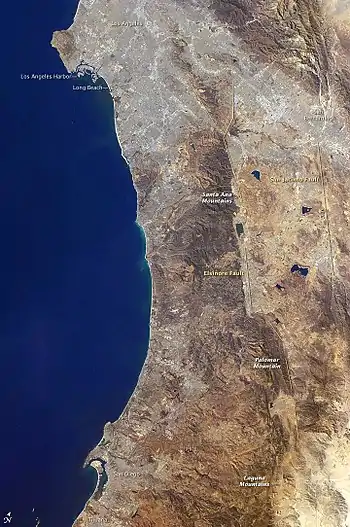Elsinore Fault Zone
The Elsinore Fault Zone is a large right-lateral strike-slip geological fault structure in Southern California. The fault is part of the trilateral split of the San Andreas fault system and is one of the largest, though quietest faults in Southern California.[1][2]

Fault characteristics
The Elsinore fault zone, not including Whittier, Chino, and Laguna Salada faults, is 180 kilometers (110 mi) long with a slip-rate of 4.0 millimeters/year (0.15 in/yr). It is estimated that this zone is capable of producing a quake of 6.5–7.5 MW. The projected interval between major rupture events is 250 years.
The last major rupture event on the main Elsinore fault was in 1910 with a 6 MW earthquake centered just northwest of the city of Lake Elsinore.[3]
Fault segments and geography
The fault runs from the mountainous Peninsular Ranges region between El Centro and San Diego, northwest to the Chino Hills range and Chino Hills. On the southern end of the fault zone is the southeastern extension of the Elsinore fault zone, the Laguna Salada Fault. At its northern end, the Elsinore fault zone splits into two segments, the Chino Fault and the Whittier Fault. In the Elsinore Trough, the Elsinore fault zone creates four graben rift valleys between the Santa Ana Mountain Block and the Perris Block: the Temescal Valley, the Elsinore Valley with its large sag pond of Lake Elsinore[4] and the Temecula Valley and Wolf Valley. In the Elsinore Trough the fault zone is split into pairs of parallel strands with the Glen Ivy North Fault and Lee Lake Fault forming the first valley, the Glen Ivy South Fault and Willard Faults the second and the Willard and Wildomar Faults the last two valleys to the southeast.[5][6][2]
A multi-year study published in 2018 suggests a connection between the Elsinore Fault and other fault lines farther south, in Mexico: "...observations of the Yuha Desert and Salton Trough suggest that the 2010 M7.2 El Mayor ‐ Cucapah earthquake rupture, the Laguna Salada fault in Baja California, Mexico, and the Elsinore fault in California are part of the same fault system."[7]
References
- "The San Andreas Fault System". SDSU.edu. Retrieved 2010-09-18.
- "Elsinore Fault Zone". Southern California Earthquake Data Center. Retrieved 2010-09-18.
- "Elsinore Earthquake". Southern California Earthquake Data Center. Retrieved 2010-09-18.
- Lin II, Rong-Gong (2017-03-21). "Notorious L.A. earthquake fault more dangerous than experts believed, new research shows". Los Angeles Times. Retrieved 2019-10-22.
- Rene Engel (1959), Geology and Mineral Deposits of the Lake Elsinore Quadrangle California, California Department of Natural Resources, Bulletin 146, Division of Mines, pp. 14, 55–51.
- Robert A. Larson; James E. Slosson (1997). Storm-induced Geologic Hazards: Case Histories from the 1992-1993 Winter in Southern California and Arizona. Fig. 1. 11. Geological Society of America. p. 50. ISBN 978-0-8137-4111-6.
- Donnellan, Andrea; Parker, Jay; Heflin, Michael; Lyzenga, Gregory; Moore, Angelyn; Ludwig, Lisa Grant; Rundle, John; Wang, Jun; Pierce, Marlon (2018). "Fracture Advancing Step Tectonics Observed in the Yuha Desert and Ocotillo, CA, Following the 2010 Mw7.2 el Mayor-Cucapah Earthquake". Earth and Space Science. 5 (9): 456–472. Bibcode:2018E&SS....5..456D. doi:10.1029/2017EA000351.
Further reading
- Mann, John Francis (October 1955). Geology of a Portion of the Elsinore Fault Zone, California. State of California, Department of Natural Resources, Division of Mines.
- Weber, F. Harold (1963). Geology and mineral resources of San Diego County, California. California Division of Mines and Geology.